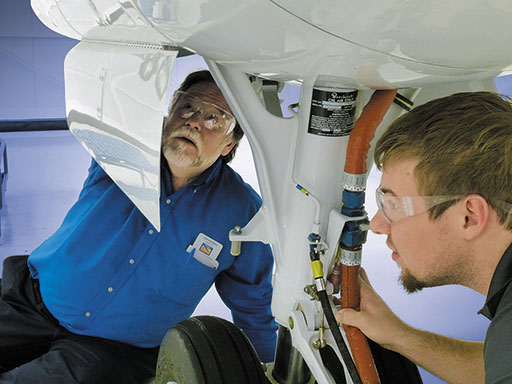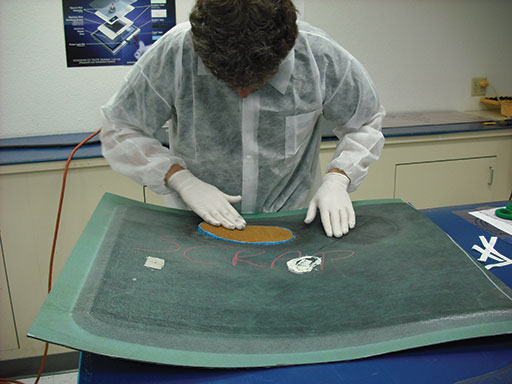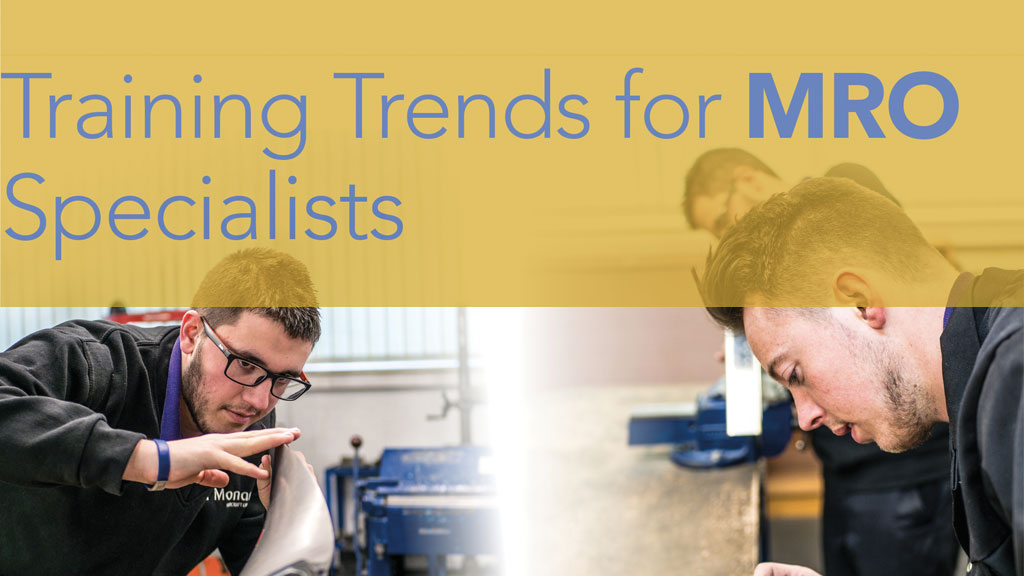As aircraft maintenance becomes more technical, MROs are increasing training in specialized areas to help differentiate themselves and provide improved services for their customers.
Today’s MROs are faced with a bit of a dilemma: On one hand they are providing inspections and maintenance for a fleet of legacy aircraft. Many of which should have been retired long ago. On the other, they are tasked with inspecting and maintaining a growing fleet of next-generation aircraft, that are introducing all kinds of exotic materials and manufacturing techniques.
The result is the growing need to provide specialized training for their technicians that covers a widening spectrum of disciplines. In so many instances, on-the-job-training just won’t cut it any longer. MROs need to be able to provide the services their customers’ need, when they need them, if they want to survive in this increasingly competitive market.
So what are some of the hottest trends in specialized MRO training you ask? A quick and very unofficial pole highlighted non-destructive testing (NDT), advanced composites repairs, troubleshooting and (TBD) as four of the top needs.
Certification and Compliance for NDT
While earning the necessary accreditations for non-destructive testing has always required a combination of experience and formal training, the introduction of new NDT technologies has pushed the need for specialized training even higher.
“Three of the newer NDT techniques, Phased Array (ultrasonic), Computed and Digital Radiography require their own specialized training courses to meet industry certification requirements,” explained Eric Henry, assistant manager, NDT Level III Services for Applied Technical Services (ATS). “For example, in the past, before computed and digital radiography, you had to have 80-hours of radiographic NDT training – 40-hours for Level I and 40-hours for Level II certification. That was in addition to the up to 800 hours of experience required by the different certification schemes.”
“Soon after the implementation of computed and digital radiography techniques, the industry determined that it is really important that technicians receive additional training and experience in these non-film specific techniques so they are better prepared and qualified to perform these functions to evaluate the serviceability of aircraft components,” he said. “Phased array is another new NDT technology that requires specialized training, experience and certifications.”
Henry said that MROs or NDT providers who are switching over from film or adding non-film radiography techniques are required to update their internal NDT certification program and periodically comply with these new industry requirements.
“What the industry has been working on is to introduce the requirement for technicians who already have a radiography certification for film, to now take the additional training,” he said. “It’s something our company jumped in on right away, developing courses for computed digital and film to non-film transition courses. Now we are holding these 40-hour courses almost every week to keep up with demand.”
Along with the growing need to provide the correct training for their technicians, Henry said another problem facing MROs today is the added pressure of understanding and following all of the various compliance requirements to ensure that the technicians are “qualified” do the work they need to do.
“Right now you have four different qualification/certification guidelines in use throughout our industry,” Henry said. “The challenge maintenance providers are sometimes faced with is knowing which is applicable. Furthermore, once the certification scheme is known, what is required by the maintenance provider in order to comply is not always clear.”
“Aircraft components that are considered flight critical in nature most often require NDT personnel to be certified to one of the stricter certifications such as NAS410,” he said. “NDT certification can be very confusing to MROs. A big part of my job is helping them understand their specific requirements so that we can create a certification program and road map to achieve certification for their personnel that is tailored to their specific needs. Today, the training you need is tired directly to the specific type of work you are doing.”
Putting Together a Composites Training Program
Michael Hoke, president of ABARIS Training said, what most of us know: not a lot has changed with the way basic composite structures are inspected and repaired over the past decade or so. But, that doesn’t mean that there’s nothing new for your technicians to learn.
“One of the biggest changes has been an industry trend toward the standardization of the repair materials and techniques. The lack of standardization between airframe manufacturers has long been a problem for technicians and MROs,” he said. “For example, a technician working on a Boeing airplane today will do a repair to a composite control surface one way. Then the next day if he does a similar repair to an Airbus airplane and goes to the structural repair manual (SRM), he’s faced with doing the repair a completely different way.”
“In many cases, the SRMs were not only different they could be contradictory to each other,” he said. “One SRM may prohibit a technique and the other may require it. That is very tough on the technician.”
Hoke said that it’s also been hard on the trainers tasked with teaching composite repairs. A problem that’s only been compounded because the major airframes like Airbus and Boeing have kept their SRMs proprietary so there has been no way for trainers like ABARIS to use the materials in the classroom.
He also explained thanks to the efforts of the FAA and the Commercial Aircraft Composite Repair Committee (CACRC), a technical committee of the SAE, over the past few years the trend has been towards standardizing many of the composite repair processes between the manufacturers. But it’s not too widespread yet. So ABARIS has tweaked its training to meet the need.
“One of the newer segments we have added to our composites training curriculum is an SRM comparison class, which teaches a technician how to compare different SRM styles from various commercial and military aircraft manufacturers,” he said. “Of course, we are limited due to the fact that we don’t have access to the actual SRMs.”

So what ABARIS, along with help from the FAA, has done has been to create its own set of what they call Training Repair Manuals (TRMs).
“The TRMs are very similar to the SRMs. We follow the current ATA 100 standards so that Chapter 51 is always the Basic Composites chapter, same as it is in the Boeing or Airbus SRM,” Hoke said. “We wrote all the repair instructions ourselves, but we used combinations of techniques from all the major manufacturers including the military and drone OEMs. Our goal was to come up with a balanced approach to a repair procedure.”
“If a technician can read and interpret the TRM and successfully follow the instructions, then when they return to work and have their nose buried in an Airbus or Lockheed SRM, they will find it familiar and easier to understand,” he said.
Troubleshooting in the Digital Age
Ask any younger technician about how they troubleshoot a new-generation business or commercial aircraft and they’re likely to say it’s as easy as plugging in a laptop and tapping a few keys. The aircraft will do the rest. While that methodology may work most of the time, the fact is, it doesn’t work all of the time.
“Technology is a great starting point for troubleshooting because it improves the efficiency and accuracy of the basic troubleshooting process,” explained Brian Goodsite, Center Manager at FlightSafety International’s Wichita Maintenance Learning Center.

“However, it is likely that sooner or later you will be working an aircraft and its systems will indicate either an inaccurate or false reading – or perhaps, it won’t register any faults at all. What do you do then?” he said. “Unfortunately, troubleshooting is becoming a lost art – too many technicians do not have the good baseline troubleshooting skills they need to go beyond what technology can tell them about a problem,”
“Situations like this are why FlightSafety’s 20-hour, Principles of Troubleshooting course is is one of our most important and popular programs,” Mike Hoffman, Program Manager at FlightSafety International’s Wichita Maintenance Learning Center said. “The basic four-step troubleshooting process remains the most critical and necessary element of our program. It covers the basic troubleshooting skills that are being lost in today’s ever-advancing world of technology.”
Hoffman said that while FlightSafety’s program teaches “basic troubleshooting skills,” it is just as valuable as a refresher for the more experienced technicians.
“We have technicians come here who have years of experience on all types of aircraft and our intent is not to replace what they already know, but to give them new troubleshooting tools to do it even better,” he said. “I’ve had technicians with 27-years of experience come take the class and say they wished they’d had this information from the beginning.”
Goodsite explained that the intent of their program is to put technicians on a logical troubleshooting path.
“Plan your work and then work your plan,” he said. “There is no point in creating a plan and then not following it.”
And while FlightSafety International’s Principles of Troubleshooting class is based on years of proven insights, Goodsite said that the company is about ready to roll out a new and updated class that introduces some new processes and steps.
“We recognize that technology and processes are continually changing, so we have refreshed our program with more troubleshooting scenarios that integrate the additional use of aircraft self-diagnostics systems,” he said. “We are also introducing new simulation systems with improved graphics that are more tailored to the types of situations technicians will see out in the field.”
“Our goal has always been to give technicians the skills they need to do their jobs faster and more accurately no matter what types of aircraft they are working on,” Hoffman said. “Both our current Principles of Troubleshooting class and the new one that will come out by the end of the year are created to give technicians greater skills and confidence.”
MAEL Takes Training In-House
To help ensure it can continue to feed the ongoing need for new technicians. U.K.-based Monarch Aircraft Engineering is taking an “in-house” approach to recruiting and training technicians. To meet their need, the company started the Monarch Aircraft Engineering Training Academy located in Luton, England.
“We believe in integrated and strategic training that is aligned with the goals of the business and the individual’s personal development plan,” stated Monarch’s Head of Learning and Development, Dean Giles. “It can take considerable time for aircraft maintenance personnel to reach their full potential. This is why, through our Part 147 training organization, we are exploring more digital training tools that are more readily available to help us reduce training times through the replication of aircraft in a more virtual setting.”
“The use of emerging technologies in learning are creating great opportunities when it comes to developing the full potential of our people,” he said. “These will enable us to deliver more immersive learning experiences that have ever been possible before.”
Of course, advanced technology is just one piece of the puzzle that only works if you have skilled and knowledgeable technicians to train. And in Monarch’s case, that knowledge base begins with an active apprenticeship program.
“Our apprenticeship program, which has doubled in size in 2018, is responding to this building our own skilled workforce and bringing in a diverse pipeline of talent to meet existing and future skills gaps,” Giles explained. “We will develop a breadth and depth of expertise through a variety of apprenticeships, from entry-level skills to higher- and degree-level apprenticeships, that are open to both new recruits and existing employees.”
Whether through the apprenticeship program or with a mentor or coach, Giles said that much of Monarch Aircraft Engineering’s new direction acknowledges the company’s core belief that a greater proportion of learning happens informally. This means that company managers are becoming actively involved in learning within the workplace itself and are actively trying to embed teaching and sharing as part of all of their interactions with their various team members.
